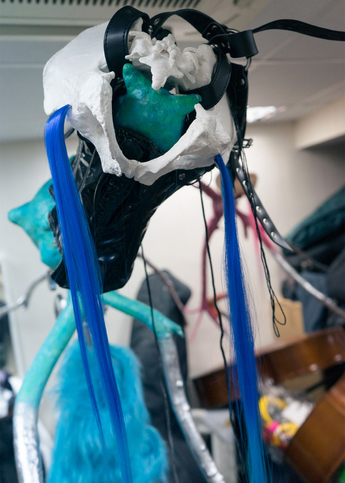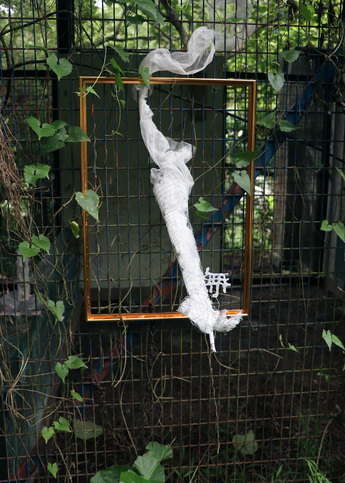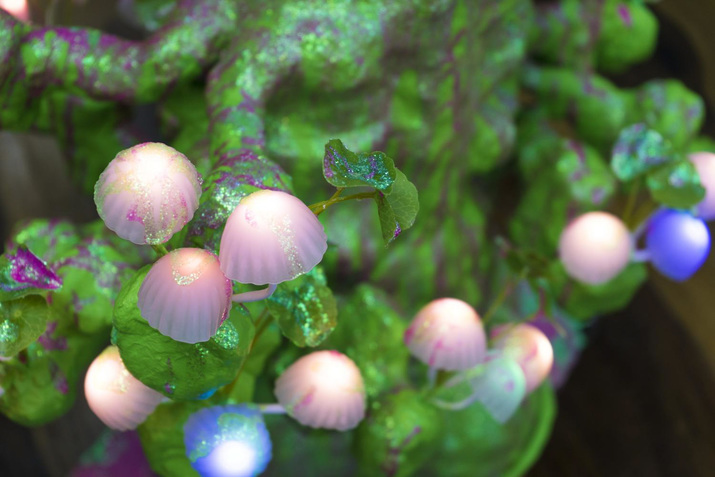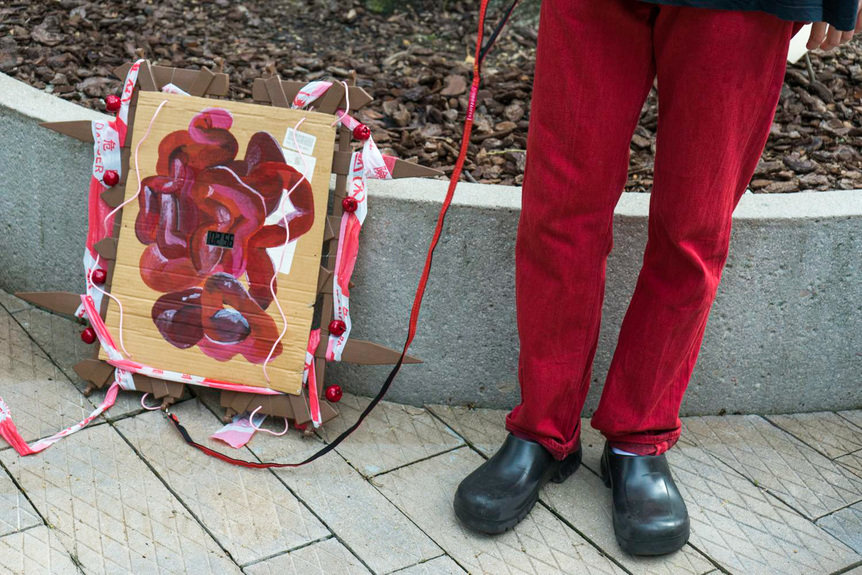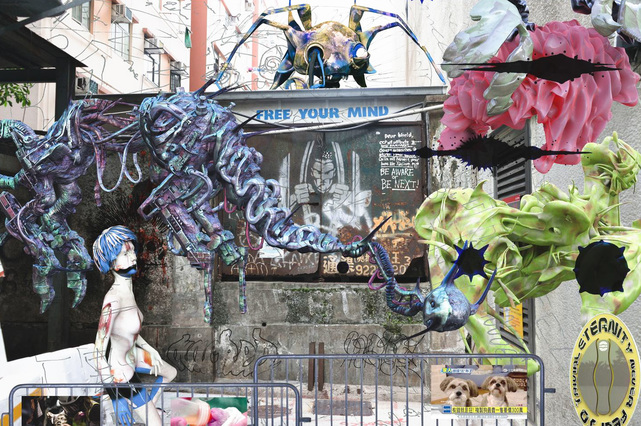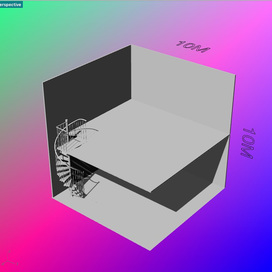
R
E
V N
E
X
T
Long before our present battles against a pandemic and economic recessions, the art world has been in a state of disintegration. In Hong Kong, galleries have escaped from high-rent areas, while experimental spaces have fallen under police crackdowns. Meanwhile, on a global scale, sociopolitical changes are unfolding at an accelerated pace. A dealer noted in this year’s Art Basel and UBS Global Art Market Report that “distractions and anxieties can take people away from buying art.” It seems that the art market is at danger of falling to the wayside due to its failures to reflect our urgent preoccupations.
Still, growth is possible. Aiming to break new ground in the art world through rhizomatic thinking, the network of practitioners known as prsntprsnt creates both IRL and virtual projects to explore creative methods that are conditioned purely by the present moment, as well as the possibilities of eliminating capitalistic notions of object ownership. For their 2020 happening “Pilgrimage,” the artists created installations at a former British military camp in Hong Kong. Given the remoteness of the site, the majority of viewers encountered the works via photographic documentation on the web, as was intended by prsntprsnt. Documentation was likewise key to the guerrilla event “TekKwun,” for which they infiltrated and temporarily installed works at a Tai Kwun show in Hong Kong, and then disseminated the projects on social media as flattened images that circulate indefinitely. In “10×10,” artworks were presented in a virtual white cube. ArtAsiaPacific caught up with the mysterious group to talk about art making that dissolves the significance of material, anarchic spaces, and the impermanence of all things.
How would you describe the aesthetic of prsntprsnt?
There isn’t a singular aesthetic. As a platform and initiative, prsntprsnt are concerned with shifting current modes of art dissemination, and creating new methodologies for exhibition making. This includes utilizing the documentation of artworks as a primary exhibition medium. We are not a collective, but rather a loose network of individual artists with our own discrete agendas in the world.
Why did you name yourselves prsntprsnt?
Prsntprsnt is an alias for prsnt.prjcts (Present Projects). It is written in a way that is unpronounceable, referencing the abstract nature of time, which cannot be accurately described.
As an entity, we prioritize contemporaneity, disregarding the past and the anticipation of the future to focus on what is relevant to us solely at this moment as artists. This provides immense freedom for our expressions and allows us to create spontaneously based on what we see upon arrival to a site. For example, during “Pilgrimage,” Jennnital placed a balloon dog over a dog skeleton that we coincidentally found at the army camp, for 長長狗狗 (2020).
How did prsntprsnt start?
Our first show that dealt with documentation as an art medium was “New Babylon” in December 2019. Prior to that, we did a screening with Video Cypher, a video art initiative started by Anna Chim in 2017, and private showcases of artworks inside a violin shop.
“New Babylon” was a proposition for a space that defies organization—a plane of immanence for deterritorialization in Deleuzian terms—at an Airbnb listing. New Babylon contrasts traditional and bureaucratic spaces of art dissemination, such as the gallery, institutions, and even project spaces. There was no curation besides choosing the artists; nobody knew what the artworks would look like until the day of installation. The Airbnb we rented acted mainly as a site to produce an aura: a visual quality that is atmospherically intense and that is capable of producing strong intellectual connections and/or visceral responses—in short, a potent viewing experience. During our occupation of the site, there were spontaneous activities: new works were made, people got tattooed. The show was metamorphosis on display, but for us, the attendance of the show was secondary to the artwork documentation. In terms of our visual records of artworks, we prioritize formal aesthetics over conceptual concerns. However, these images are often conceptually rich after they have been produced.
You seem to embrace both inaccessibility and accessibility—access to your IRL works is limited, but the documentation is openly disseminated on the internet. Why?
Though we work in non-hierarchical and open-ended ways, we refuse to be populists. We do not intend to align with the status quo or attract a wider audience. Phoney community-driven art practices don’t appeal to us. Most of these initiatives are in fact driven by personal agendas, promoted in the name of “community.”
On the other hand, top-down, curator-led exhibitions laden with theoretical jargon and name dropping have no potential to generate new knowledge. We believe in rhizomatic and horizontal structures of knowledge generation, with the artist taking full control over what they bring to the table, and the curatorial statement being merely a poetic concluding text written after the show, creating new understandings of aesthetics, art making, and art’s dissemination.
With digital means, we can partake in the decentralization of dominant powers along with other people with similar interests on the internet. Particularly, social media eradicates the classist system of art ownership and viewing, and allows us to avoid real life interactions, which is ideal for some of us.
In a world where everything can be art, how do you make meaningful art?
Art is meaningless just like most things. Everything can be art but there is still good and bad art, and that is decided by personal taste. The art world privileges artworks that can be easily capitalized. Our non-object-oriented process of dissemination disregards the object’s value—the image of the object conveys meaning rather than the object itself. The image becomes a non-capitalizable object that carries meaning free of the restrictions of capitalism.
Your group has sold art online through webstores and Instagram. Is that model of trading sustainable?
Historically and systematically, artists were never in a position to grow the monetary value attached to their own art by themselves. Sometimes we sell for fun, mainly to friends who want to own something they really liked. But art on the internet will exist until the end of the internet—it doesn’t disappear. So, in that way, digital art has yet to be fully commodified, for now. The primal urge to create will always be present regardless of the market. We channel this urge through an array of formats and mediums, so that we can be truly feral in our practices.
Tell us about “TekKwun.” How did you come up with this idea?
“TekKwun” was spontaneously conceived through a couple of messages in our group chat. We thought Tai Kwun was visually interesting as a site, so we responded to spaces such as the former prison cells, white-cube galleries, and the visitor centre through installations.
The site of Tai Kwun has other significances. When we were mounting the works there, the security was particularly strict, perhaps due to the recent protests in the city. We were questioned a few times about our intentions and every time we replied that we were there to 打卡 (Chinese slang for taking pictures at certain places with cultural capital to upload on social media for clout and social status—if you go to Tai Kwun’s location tag on Instagram, you’ll know what we’re talking about).
Do you have an antagonistic relationship to the art institutions of Hong Kong?
Institutions will always make themselves appealing to the public, the status quo, and protect the stakes of capital. In contrast, our practices are niche and highly specific.
Is it correct to say that you are not concerned about protesting or overthrowing the existing power structure? That creating your own art and methodologies is enough?
Protesting is futile. Real anarchy and freedom happens under the surface without encountering the state. Within this small window of freedom we can play and be profane. We are merely providing an alternative platform for artists to disseminate their work. We work with the internet because it is democratic and anarchic—there, one does not necessarily have to have capital to access information.
The symbol “無” (meaning “nothing” in Chinese) is common in the your works. What does 無 mean to you?
無 represents a nihilistic energy that resonates with a lot of us. Despite the complexity of the strokes, the character still means “nothing,” which is heavily referenced in Buddhism. In Daoism, nothingness refers to a primordial chaos that has the potential to generate everything. We embrace that.
Prsntprsnt’s New Babylon Manifesto calls for a “return to the uncontaminated expressions, untouched by insatiable capitalist desires and demands.” It also states that, in New Babylon, “Everything is secondary to the art itself and the process of intellectual, visual, and social exchange.” Do you think this utopia can ever be reached?
Temporarily, yes. A dinner party, for example, can briefly accommodate anarchic states of being. Nothing really lasts permanently in the world anyway.
Peter Chung is ArtAsiaPacific’s photo editor.
Prsntprsnt’s “Underground Flower x Prsntprsnt: Cellophane Mother Memory” is on view on its website.
To read more of ArtAsiaPacific’s articles, visit our Digital Library.


